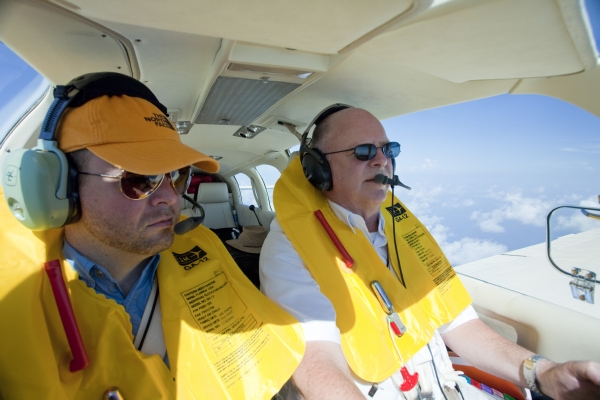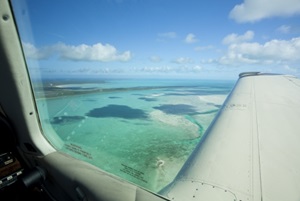Caribbean

Flying in the Caribbean
Want to fly to Cuba?
See the information below for the latest regulations on GA travel to Cuba.
Other Caribbean Destinations
The information here applies to the Turks and Caicos, Dominican Republic, Haiti, Cayman Islands, Jamaica, Puerto Rico , U.S. and British Virgin Islands, Anguilla, the French West Indies, Netherland Antilles, Nevis and St. Kitts, Antigua and Barbuda, Montserrat, Dominica, St. Lucia, St. Vincent and Grenadines, Barbados, Grenada and Carraicou, Trinidad and Tobago.
Because many different countries govern the islands of the Caribbean, it is necessary to clear Customs and Immigration when entering and exiting each one.
In addition to the information offered here, you may find the Caribbean Pilot's Guide a helpful resource.
And, as always, call AOPA with questions, Monday through Friday, 8:30 a.m. to 6:00 p.m. Eastern Time, (800) USA-AOPA (872-2672).
Preparation
 Pilot-in-Command
Pilot-in-Command
The pilot in command must have a current:
- Passport
- Pilot certificate with an English-proficient endorsement
- Medical certificate (although BasicMed is accepted in the Bahamas, it may not be accepted in other Caribbean countries. AOPA advises to verify beforehand.)
- Restricted radiotelephone operators permit. For more information on FCC requirements, click here.
- Letter of Authorization if the aircraft is not registered in the pilot's name
Passengers
- Each passenger must have a current passport
- Children traveling with only one parent must have a notarized statement of approval from the absent parent stating the dates of the trip.
Aircraft
All U.S. registered aircraft must have:
- A standard Airworthiness Certificate
- A permanent registration certificate (no temporary certificates/pink slips)
- A radio station license. For more information on FCC requirements, click here.
- Operating limitations information
- Weight and Balance information
- A life vest/flotation device for each person aboard (It’s recommended you also carry a life raft.)
- An ID data plate
- 12-inch registration marks
- Transponder with Mode C
- Aircraft with fuel tanks installed in the baggage or passenger compartments must have Form 337 on board.
Insurance
Contact your insurance company before you leave the U.S. to be sure you are covered. AssuredPartners Aerospace will be glad to talk with you about your planned trip. 800/622-2672.
Customs and Border Protection (CBP)
- CBP General Aviation Processing webpage – central CBP resource for GA operations, including
- eAPIS links and instructions
- Border Overflight Exemption (BOE) information
- GA Airport Fact Sheets
- FAQs
- General cross-border operating instructions and expectations
- Direct link to eAPIS
- Direct link to DHS user fee decal information
- Allow a few weeks for delivery. Decals can be purchased online. For decal questions, call (317)-298-1245 or send an email to [email protected].
- All pilots crossing the U.S. border inbound or outbound are required to use Custom and Border Protection's (CBP) Electronic Advance Passenger Information System (eAPIS) to provide crew, passenger(s), aircraft, and trip information. The eAPIS information must be filed at least one hour before departing from or arriving in the United States, but pilots can file as far in advance as they wish, giving the option to provide information for the return trip via Internet before leaving home. eAPIS is not required if you overfly Canada going from one U.S. airport to another without landing.
- All pilots crossing the U.S. border inbound must secure permission to land from their CBP port of arrival, after submitting eAPIS and before departing from their country of origin.
ICAO Flight Plan
- Use of an ICAO flight plan is currently required if the flight will enter international airspace. While an ICAO flight plan and an FAA flight plan are similar in many ways, there are some important differences. Some items are the same on both forms: aircraft ID or tail number; aircraft type, fuel endurance, and number of people on board. New items on the ICAO flight plan include a Wake Turbulence category, and Type of Flight. The biggest change, though, is found in the equipment suffixes box, box 10. The ICAO codes used to denote the type of equipment on board the aircraft are different than the codes used by the FAA. To find out more, please view this short AOPA video.
Departure
 Departure from U.S.
Departure from U.S.
- Pilots crossing the U.S. border must be in communication with ATC and on a discrete squawk code.
- All aircraft must be on an activated IFR or Defense VFR flight plan for flying through the ADIZ
- Visiting pilots must enter and exit at an airport of entry.
- Know the requirements for the islands you plan to visit.
The Islands
 The Islands
The Islands
General Information
- Typically, you will encounter little general aviation traffic over the water until you get close to an island airport.
- Some of the Caribbean countries have radar.
- You will change controllers as you fly from country to country, as they will hand you off at their boundaries.
- VFR flights are not permitted after dark.
- Fuel is usually available at most airports, but can be very expensive. Credit cards are not always accepted.
- Most of the island airports are airports of entry, but not all. Check your specific airport if you are not sure. Customs and Immigration at many airports requires advance notice, some as much as 24 hours.
- All countries require flight plans.
- No vaccinations are required of U.S. citizens.
- Navigational aids may or may not be functional in the Caribbeean. Flying with GPS makes it easier to navigate.
- Most towered airports provide weather information and Internet is available in most places.
- Caricom eAPIS: Caricom (Caribbean Community) requires all aircraft to submit an APIS manifest prior to arrival, departure, or travel between any of the following: Antigua & Barbuda, Barbados, Belize, Caymans, Dominica, Granada, Guyana, Haiti, Jamaica, Montserrat, St Kitts & Nevis, St. Lucia, St. Vincent & the Grenadines, Trinidad & Tobago.
Notes on specific countries:
Puerto Rico
If you fly from Puerto Rico to the U.S. Virgin Islands, you can fly as a domestic flight with no eAPIS or CBP entry requirements, just fly and land. However, if you fly from the U.S. Virgin Islands to Puerto Rico, you must clear with CBP at an international port. However, you do not file an eAPIS; you file the old CBP Form 178 and request permission and an appointment.
Virgin Islands
AOPA has become aware of an issue regarding travel to the U.S. Virgin Islands and points south. U.S. Customs in St. Thomas says that pilots need to file an eAPIS outbound and nothing else. U.S. Customs in St. Croix says that pilots DO NOT need to file an eAPIS, but DO need to go the the CBP office. U.S. Customs headquarters is aware of this discrepancy and is working with the local offices to resolve. In the meantime, it would be wise to contact the specific U.S. Customs offices you intend to use in the area by phone prior to departure or arrival, and to confirm which procedure to use.
Return
Returning to the U.S.
- File an activated IFR or Defense VFR flight plan for flying through the ADIZ with ADCUS (advise customs) in the remarks section
- Call U.S. CBP at least one hour and no more than 23 hours before your planned U.S. arrival time. (Do not rely only on ADCUS – call to verify CBP has your flight plan).
- File an eAPIS arrival manifest (if you filed eAPIS reports for both legs of your trip before you left the U.S., you do not have to file again).
- If you are arriving in southern Florida, plan to land at one of the following eight U.S. CBP airport of entry after crossing the U.S. border. Be on time – a little late is better than early.
- Key West International Airport, (KEYW)
- Tamiami Airport, Miami (KTMB)
- Miami International Airport General Aviation Center (KMIA)
- Opa Locka Airport, Miami (KOPF)
- Fort Lauderdale Executive Airport (KFXE)
- Fort Lauderdale Hollywood International-General Aviation Facility (KFLL)
- Palm Beach International Airport, West Palm Beach (KPBI)
- Saint Lucie County Airport, Fort Pierce (KFPR)
Cuba
Cuba Travel Update
Tourism: Still prohibited
Travel to Cuba for the purpose of tourism is not allowed and the Cuban embargo does still remain in place. The U.S. Treasury Department’s Office of Foreign Asset Control (OFAC) continues to enforce the Cuban Asset Control Regulations. More details are available on OFAC’s Cuba pages as well as a list of frequently asked questions.
Insurance Coverage
Aircraft owners should check with their insurance carriers before traveling to Cuba to be certain they are covered for the trip. U.S. insurers can continue to provide health, life, and travel insurance-related services for U.S. travelers to Cuba, but under regulatory changes, they can also provide insurance coverage for global health, life, or travel to residents of other countries for travel to or within Cuba.
Financed Aircraft
If your aircraft is financed, your lender may have restrictions on operations to Cuba. Before traveling to Cuba, contact your lender to make sure the trip is permissible under the terms of your agreement.
Visas and Immigration
All travelers to Cuba, including religious workers, should contact the Cuban Embassy in Washington DC to determine the appropriate type of visa required for their purpose of travel.
Cuba’s immigration rules are strict, and attempts to enter or exit Cuba illegally, or to aid the irregular exit of Cuban nationals or other persons, are prohibited. Immigration violators are subject to prison terms ranging from four years for illegal entry or exit to as many as 30 years for aggravated cases of alien smuggling.
Entering Cuban territory, territorial waters or airspace (generally within 12 nautical miles of the Cuban coast) without prior authorization from the Cuban government may result in arrest or other enforcement action by Cuban authorities.
Health and Medical Requirements
Cuba requires visitors to have non-U.S. medical insurance, and sells a temporary policy to those who do not have such insurance. More information is on the Cuban Embassy web site.
Cuban authorities do not demand HIV tests of travelers to Cuba, with the exception of foreign students on scholarships. The Cuban authorities accept the results of HIV test conducted by labs in the U.S. Please verify this information with the Cuban Embassy before traveling.
U.S. airports for departure and return
Under new rules, general aviation aircraft may depart and return from any U.S. Airport of Entry (previously there were only certain approved airports). Departure and return can be from different airports.
FAA Regulations: FAR 91.709 Operations to Cuba
No person may operate a civil aircraft from the United States to Cuba unless—
(a) Departure is from an international airport of entry designated in § 6.13 of the Air Commerce Regulations of the Bureau of Customs (19 CFR 6.13); and
(b) In the case of departure from any of the 48 contiguous States or the District of Columbia, the pilot in command of the aircraft has filed—
(1) A DVFR or IFR flight plan as prescribed in § 99.11 or § 99.13 of this chapter; and
(2) A written statement, within 1 hour before departure, with the Office of Immigration and Naturalization Service at the airport of departure, containing—
(i) All information in the flight plan;
(ii) The name of each occupant of the aircraft;
(iii) The number of occupants of the aircraft; and(iv) A description of the cargo, if any.This section does not apply to the operation of aircraft by a scheduled air carrier over routes authorized in operations specifications issued by the Administrator.(Approved by the Office of Management and Budget under control number 2120-0005) and
(iv) A description of the cargo, if any.
This section does not apply to the operation of aircraft by a scheduled air carrier over routes authorized in operations specifications issued by the Administrator.
Overflying Cuba – You still need a permit
Civil aircraft overfly Cuba routinely. It is not especially difficult, but it does require that pilots follow the established procedures. Private pilots with overflight permits may fly through Cuban airspace via published airways. These airways are shown on the Caribbean and South American IFR Low Altitude Enroute Charts.
The process for acquiring the overflight permits has changed in recent years. As of December 2013, a modification of the U.S. Code of Regulations allows operators of U.S. registered aircraft to contact Cuba directly and pay Cuba for overflight permits without the need for an Office of Foreign Assets Control (OFAC) license. Payment is made to Cuba in Euros through a bank in Panama. If you do not want to complete the permit application process yourself, you can use a third party provider for a fee. Regardless of how you choose to obtain an overflight permit, it is critical to do so. At the same time, Cuba has tightened up on the issuance of permits. The primary changes are: Aircraft with an MTOW greater than 6,600 pounds will not be exempted from permit or airspace fees, regardless of who is flying the aircraft or the purpose of the flight.
All permits requested by companies on behalf of third parties will be assessed permit or airspace fees. For a flight to be exempted from the Cuban permit fees, the owner of the aircraft must contact the Cuban permit department directly to request the permit and the exemption. The Cuban authorities will evaluate each request individually and only they can decide what flights will be exempted. The Cuban Permit department has stated that NO aircraft registered in the name of a corporation (regardless of whether it is engaged in a commercial operation or not) will be exempted from airspace fees.
Click here to read answers to frequently asked questions related to Cuba.